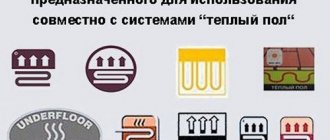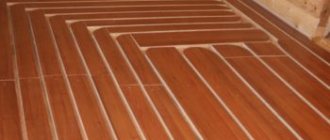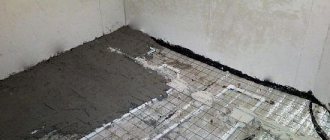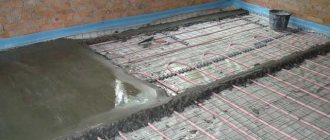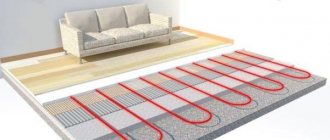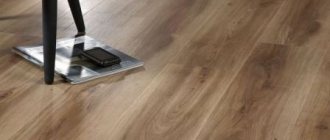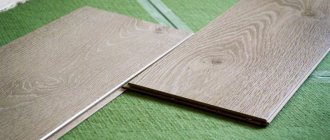Here you will learn:
- Purpose of the substrate under the laminate
- Advantages of a quality substrate
- Which substrate to choose for laminate
- Installation of the substrate
Heated floors are often preferred to radiators because they are better than radiators: convection currents rise from bottom to top, and even with very hot radiators, the floor in the room can remain cold.
A water floor does not radiate heat as evenly as an electric one: the cable heats up equally along its entire length, and the coolant in the pipe cools as it moves away from the boiler. But laying in a spiral (otherwise known as a “snail”) compensates for this disadvantage: the hot part of the pipe runs along the walls, the cold part ends up in the center of the room, and the center is objectively warmer.
In order for the thermal efficiency of the floor to be high, it is not enough to ensure a suitable temperature of the pipeline itself. It is important that all layers located above the pipe (screed, substrate, coating itself) have high thermal conductivity. Otherwise, the coating will warm up from the inside instead of radiating heat into the room.
On the base side, it is necessary to lay insulation and a reflective layer (foil or foil-coated materials are used for this purpose). Otherwise, some of the heat from the pipes will go down, not up, and this will also reduce the thermal efficiency of the structure.
Requirement for the pipeline: threaded and coupling connections cannot be used. The pipe must be continuous; the sections are connected by welding/soldering. In the event of a leak, the entire floor will have to be raised.
To install the floor you will also need:
- distribution and/or main collector;
- circulation pump.
The permissible length of the water circuit is one hundred meters maximum (about 40 square meters). If more is required, more than one circuit must be made.
Why do you need a laminate underlay?
Floating floors, which include laminate and parquet, are not attached to the base. The coupling device for the coating strips is designed by connecting them to each other. And to cushion the floor, a substrate is laid under the laminate, which performs several functions.
- First of all, it is needed to insulate between the base and the laminate from noise. If a laminate floor is laid without a backing, sand grains from the screed and other debris will creak loudly when walking. I’m telling you this because I was once asked not to lay a bedding so as not to heat the neighbors’ ceiling.
- Secondly, the bedding serves to protect the coating from moisture from possible condensation from the concrete. For an apartment with central heating, this parameter is not so important. There is practically no residual moisture in the concrete screed. In addition, the back of the laminate consists of a protective waterproof layer of laminate or kraft paper, on which liquid rolls off and does not penetrate the HDF board.
By the way: linoleum or carpet can serve as a substrate for laying laminate flooring. This option is not professional and serves as an example. Although the floating floor has been laid directly on the linoleum more than once.
A short article: about laying laminate flooring on linoleum - is it possible or not!
Types of heated floors
Water
Most often it is installed in private houses or in high-rise buildings with an individual type of heating. The water heated floor consists of a metal-plastic pipeline through which hot water circulates. Heating occurs due to an individual boiler.
Electric
There are two types of electric heated floors:
- film (more common) - heating is carried out due to infrared radiation;
- cable - heat is radiated from the cable due to internal conductive elements.
Requirements of laminate manufacturers for underlay and base
According to Russian law, laminate manufacturers are required to provide a guarantee for their products. And the requirements for preparing the foundation are the highest. If at least one of the conditions is not met, you can forget about the warranty case.
- Floor evenness - the difference should not exceed 2 mm per 1 linear meter. In my practice, even in new houses these conditions are not always met.
- The base must be dry. A vapor barrier film must be laid under the substrate.
In general, with a guarantee everything is quite complicated, there is a whole mutual responsibility. Laminate manufacturers refer to the substrate as to what it should be like. Underpads with questionable moisture-proofing material indicate the need to install a vapor barrier film. Although a vapor barrier protects the laminate from moisture, it increases the possibility of mold.
- Article about laminate locks
Some laminate manufacturers provide a guarantee only for the abrasion of the top layer, in other words, there is none. Quick-Step, for example, does not indicate what it covers or how it is implemented.
During my work, I have never encountered a warranty replacement of already installed laminate flooring. Several times customers changed the laminated coating because it simply did not assemble due to defective locks - the products were of Chinese origin. Therefore, when laying the floor covering, I would not focus on compliance with the warranty case.
Installation
The substrate is spread on the base. The materials under the laminate are laid end to end. Connect the sheets using tape. Next, a heating film or heating mat is laid on the substrate, or a cable is laid. The structural elements of the heated floor are laid 100 mm from any of the walls.
Next, the floor elements are connected to each other. Then install a temperature sensor and check the operation of the heating elements. Then a vapor barrier is laid on top of the installed heating elements, and then the finishing coating can be installed.
The underlay should be used not only under laminate, but also under other coverings, as well as under warm floors. Without a backing, such heating structures lose their effectiveness and can destroy the decorative finish of the floor.
UNIPLEX Ecoline felt underlay - new insulation for floor coverings
Felt underlay for Uniplex Ecoline floor coverings 3mm thick is a new high-quality product on our market. Unfortunately, it is practically not represented in a wide range of retail stores, but in vain.
Found this background on:
Uniplex on Yandex Market
Uniplex on Ozon
I use this service regularly myself. It’s more convenient for me to use Yandex Market because of free delivery from 700 rubles.
Uniplex is a well-designed underlay for the installation of floating floor coverings, such as laminate, parquet boards. The secret is that felted felt is environmentally friendly and has a high density. This results in minimal shrinkage and has a beneficial effect on the durability of the lock joint.
The rolled film gives the product a neat appearance. It does not emit any odor, unlike low-quality polyethylene, which is regularly offered in chain stores for money or in specialized stores as a gift (for a bunch). It prevents the laminate from penetrating excess moisture from concrete floors.
Moreover, a small possible amount of moisture can dissipate in the felt itself in the air passages between the fibers. In principle, in houses with central heating, any substrate can be laid without film, except, perhaps, on the first floors with damp basements.
Thus, we obtain a technically more complex composite product consisting of several types of material.
Felt backing Uniplex, cork, pine - comparison
Uniplex felt underlayment is closest in performance to cork insulation.
- Felt and cork have excellent sound absorption, that is, they dampen impact noise. But cork with a thickness of 2 mm loses, and 3 mm is more expensive and costs about 300 rubles / m2 versus 200 rubles for felt. Due to its high hardness, coniferous insulation reflects impact noise (the sound of footsteps) and creates a drum effect in the room.
- Uniplex with pine needles is superior in structure to cork in terms of insulating sound waves (voices, music).
- It is more convenient to lay a cork lining, although half a meter from each roll cannot be used. Also, from time to time it is overdried and breaks during installation. Felt insulation is difficult to cut; scissors must be used. When laying the needles according to the instructions, it takes a lot of time.
- The most hydrophobic material in this case is pine insulation. Cork is practically not afraid of moisture - tested. Uniplex is made from recycled fabric, so you don't have to worry about a little moisture.
- I would give the best leveling ability to felt insulation. It will fill small irregularities and chipped concrete well. If the base is flat and plywood or the self-leveling floor is well made, you can use felt or cork. If the base is uneven with significant holes, use pine needles on old parquet (it will create the plane required when laying laminate flooring)
- None of these underlays will significantly increase sound insulation from noisy neighbors below. There is always noise from above. For this purpose, comprehensive sound insulation of the screed and walls is carried out. But the drum effect is absorbed by the Uniplex felt backing.
Conclusion
I recommend purchasing Uniplex Ecoline underlay. It is definitely better than pine insulation and comparable to 3 mm cork insulation. But the cost... for now... is one and a half to two times cheaper.
Cork is the best insulator under ideal conditions
One of the most popular materials to work with is cork. In principle, in stores, along with coniferous insulation, it is most often offered. Now I will describe the pros and cons of this lining for various bases.
Cork backing Yandex Market
Cork backing Leroy Merlin
First of all, this material is one of the most environmentally friendly. It uses crumbs - the bark of a cork tree, glued together using a natural substance - suberin. The question of the naturalness of materials is of interest to many, thanks to the ideas presented by sellers, especially when laying parquet boards. But I would not concentrate on this factor.
- Firstly, when decorating an apartment, a lot of materials are used that contain certain not-so-healthy impurities.
- Secondly, when laying cork on a concrete base, manufacturers require that a plastic film be laid under the cork for moisture protection. This fact in itself compromises the idea of an ecological idyll.
- Thirdly, cabinet furniture made from chipboard, for example, is more harmful than any synthetic substrate and film.
For laying floor coverings, the shock-absorbing sound insulation must be 2 or 3 mm thick. The 2 mm option is widely available in stores. 3 mm still needs to be looked for. Video from 6mm!
How and why is cork underlay better than other sound insulation materials?
Why is cork underlay better than other soundproofing materials? Is it so?
Floating floors are assembled by connecting them together. The weak link in this design is the joining of the locks. These are the places where tearing and wear occur. Cork insulation is the most rigid and ensures minimal subsidence of the laminate planks, so the key joint is subject to less stress.
But there is one caveat. If the base is not level enough, the cork substrate, due to the lack of “leveling ability,” is not able to compensate for differences in the screed.
I've heard reviews that cork crumbles over time and turns into dust. If there is no excessive moisture in the base, nothing will happen to it.
The master's review of the cork backing
I would purchase and lay myself a cork underlay under a parquet board or laminate with a properly leveled screed, laying the covering on plywood and the price of the laminate starting from 800 rubles.
It is possible to lay cork as a second layer on linoleum in new buildings:
- To provide additional sound insulation
- Reluctance to remove linoleum covering
- If you doubt the ideal evenness of the base, again on linoleum
True, for this idea, which I have carried out more than once, experts will begin to throw tomatoes at me.
I would not lay a cork base on concrete without checking the levelness of the base. The price of cork is from 150 rubles/m2 for a thickness of 2 mm and above 300 rubles for 3 mm.
Technical data 2 mm
This thickness is considered minimum. With its help, it is possible to eliminate minimal unevenness of the subfloor, the size of which does not exceed 2x2 mm. The material is foamed polyethylene, inside of which there are chambers filled with air. They perfectly resist moisture and form sound and heat insulation.
This material is also in great demand due to its low cost. The advantages of the substrate include the impossibility of the formation of mold and fungi. But such a substrate has disadvantages. After laying the sheets, after some time they begin to lose their shape and become deformed under the influence of UV rays.
Coniferous substrate - why choose leafy needles?
As a craftsman, I don’t like the coniferous substrate. It is inconvenient to install because it takes longer to lay the sheets than to roll out a roll of insulation. It is advisable to glue the joints with tape to ensure that the sheets remain motionless relative to each other. This is all work that takes a lot of time, especially if you lay the “Christmas tree” using technology. Because of this, the price for work increases and it is more difficult to negotiate with customers.
Coniferous substrate on Yandex Market
Coniferous substrate in Leroy
The specified recommendations regarding the provision of a base for the flooring of a sheet coniferous substrate are confusing.
- The lining sheets must be moisture-proof from the base. This means it is necessary to lay a vapor barrier film. If you need to spread polyethylene, how then to lay the needles, keeping gaps between the sheets of several millimeters for its possible expansion when humidity increases? What if the substrate is placed diagonally, following the manufacturer’s recommendations?
Why is such a high complexity of work needed in preparation for the finishing coating given the considerable cost of the insulation itself and the installation of a generally inexpensive laminate? In such a situation, it is easier to lay the flooring by laying sheets of pine needles.
Let me tell you one incident that happened recently...
They invited us to an apartment in the city center to remove the old parquet boards and lay laminate flooring. Upon arrival, it turned out that the flooring was not laid using a floating method, but was glued to a plywood base. We decided to film.
During the long dismantling process, I learned that the man is Finnish by nationality (speaks Russian very well), married to a Russian woman. They live in Finland and rent out an apartment.
I asked what they lay on the floor in the neighboring country? He said parquet board, but not with glue, but with a lock. I asked him what kind of substrate they use? Is the flooring green? He replied that they don’t lay anything in sheets and haven’t heard of one like that, but they roll out a roll with white balls!
As I understand it, he is not a builder in the full sense of the word, and is completely unfamiliar with the assortment. But he’s a smart person who understands the topic, so you can’t call him a layman.
Coniferous substrate – on what basis and in what cases is it best to use it?
In what cases would I use pine underlayment? I would try to avoid such situations, but they occur quite regularly.
- If a situation has arisen in which the floor in the hallway is tiled, but the height of the room has not been aligned with the tiles, then it is time to use leafy needles. Fortunately, this allows you to make a large selection of material thicknesses from 3-7 mm.
- Let's say we removed the old creaky parquet flooring. The subfloor is in satisfactory condition without significant differences in the boards and there is no time or desire to change it. It is possible to use a thick sheet of spruce backing to create a rigid surface. But it is better to fix the plywood 10-12 mm. Which is preferable at the same price per m2.
Spruce insulation has high rigidity. This is good for laminate or parquet boards. However, the “leveling ability” to swallow individual tubercles is low. The material is curved - when laying the covering, it creates the feeling of a drum and unevenness of the floor. The coniferous substrate largely reflects sound back. Therefore, the advertised sound insulation creates a reflective effect. And the sound accumulates in your room.
As you can see, the pine substrate is a controversial insulator. And the price from 100-200 rubles/m2 makes the choice in its favor only due to technical necessity. I can explain its popularity by the large profit per square meter and therefore it is widely recommended by sellers.
Main functions
The main functions of the substrate are: increasing sound and thermal insulation, leveling the floor, increasing the strength of the finishing coating and uniformly distributing the load on the floor. With its help, the life of the laminate is significantly extended. Also, the underlay under the laminate makes the finishing floor covering more wear-resistant, durable and strong.
Elimination of screed surface defects
With the help of a well-chosen substrate, you can correct defects and unevenness of the concrete screed. It is not always possible to make floors perfectly flat and smooth. There will still be small differences in some places, which will negatively affect the laid laminate in the future. After all, if there are any differences in the base, there will be gaps between the panels and the floor. That is, in places with the largest gaps, the coating will sag.
Even small differences of just a few millimeters will lead to major problems with the finished floor covering over time. To prevent this, it is enough to lay a substrate under the laminate. It will hide all base errors and create a perfectly flat surface.
Some people believe that the thicker the backing, the better. In fact, this is a misconception. Because if the substrate is too thick, cracks will form faster in the finishing coating, and the laminate will simply sag under the pressure of heavy furniture items.
The ideal option is a substrate with a thickness of 3 mm.
Damping vibrational movements of the floor
Laminate floors are subject to vibrational movements caused by:
- dynamic load (walking)
- sound waves (from the noise occurring)
If no measures are taken in advance to dampen oscillatory movements, the locks on the slats will quickly fail. In this case, the problem will be solved by a well-chosen underlay for the laminate, which will act as a damper between the finishing floor covering and the concrete base.
Soundproofing
When walking on laminate flooring, two types of noise are created (the one that is heard indoors and under the floor covering). That is, when someone walks around their apartment, not only its residents suffer, but also the neighbors below. This is explained by various factors: the insufficient thickness of the laminate itself (which is only 8 mm), and the floating method of laying it (which creates an additional membrane for sound transmission). Solving this problem is quite easy if you choose the appropriate type for the laminate.
Almost all substrates have good soundproofing qualities and dampen noise in rooms. But cork products are considered the best.
Waterproofing
Laminate is a rather capricious material that does not tolerate high humidity. Therefore, before you start laying it, you need to take care of good waterproofing of the floor.
If the laminate is laid on a concrete screed, it must be dry. Otherwise, condensation will constantly accumulate between the base and the laminate. When choosing a substrate, you should carefully read its technical characteristics. Most modern materials act as waterproofing and maintain a favorable microclimate for both the concrete base and the laminated coating.
To check whether the concrete screed has dried, you need to leave a plastic bag on it overnight. If it is dry under it in the morning, then everything is in order and you can begin installing the laminate. If condensation forms under the bag, you will have to wait a little longer until the concrete dries completely.
Thermal insulation
When arranging the floor covering, it is worth considering the fact that it should be warm and pleasant to the touch. Using a well-chosen substrate will help trap warm air in the room.
Laminate itself is a fairly warm material. And if you correctly select a substrate with high thermal insulation characteristics, it will be pleasant to walk on such a coating barefoot at any time of the year.
Foam backing is the best option for inexpensive laminate
The foam backing is gas-filled polyethylene. It comes in different densities, but for floating floors, a material with a specific gravity of 18-25 kg/m3 and 2-3 mm in thickness is mainly used.
Also divided into:
- Cross-linked foam
- Uncrosslinked foams
Cross-linked foam insulation is denser and more durable, but it is not easy to find on sale, and the concept of foam backing implies the usual, most inexpensive shock absorption. Therefore, under this heading we will consider the classic version.
Leroy - uncrosslinked foam
Leroy – Cross-linked foam
Link to Petrovich - uncrosslinked foams
Roll lining is much more convenient to install than sheet lining. There is no need to put each leaf together like a puzzle and secure it with tape. Of course, in small rooms, such as corridors or rooms filled with furniture, there will not be much difference in the speed of work with one or another type of insulation.
Foamed sound insulation for laminate flooring - pros and cons
The advantages of the lining are clear - speed of installation and low price from 10 rubles/m2. In general, for an inexpensive laminate designed to last 5 years or for renting out an apartment, you can’t think of a better option. As practice shows, moral and physical wear and tear of the laminated coating occurs faster than the failure of the substrate.
In almost any case, without looking, for a laminate costing less than 500-600 rubles/m2, I recommend taking a 3 mm foam backing. Stenofon, Plenex, Porilex – it doesn’t matter, they are approximately the same.
If the surface is somewhat uneven, a 3 mm lining can level out minor differences in the base due to its own shrinkage in the tubercles.
The downside is that all the sound insulation is gradually pressed down to the thickness of a sheet of thin cardboard. This may cause the laminated coating to creak when moving. But squeaks more often occur as a result of unevenness of the base or breakage of the locking joints when assembling the laminate.
Is it possible to refuse to use a backing layer?
All of the above-described tasks that are presented to the base layer make it a mandatory purchase point when laying out a laminated coating. The only exception is the “Lux” class panels due to the fact that they already have a backing attached to the bottom of the laminated element.
Laying an additional underlay layer will lead to excessive shock absorption, which will cause the panels to sag due to walking. The slat locks will gradually begin to fail.
Quick Step underlay – branded from the manufacturer
Laminate brand Quick Step is the most popular in Russia. The substrate produced under this brand is a logical continuation of the entire product line.
Quick Step and Pergo 3 mm insulation is made from polyethylene foam, which I already wrote about. But the product of the megafactory deserves a few words.
The main difference from less expensive analogues is the higher density of the material. I couldn’t find any information about the specific gravity of Quick Step, but tactile improvement is felt. Although the same non-crosslinked polyethylene is used, gas filling occurs in different proportions.
The second advantage is the presence of a rolled polyethylene film on the reverse side. It serves for better waterproofing when laid on a concrete base.
The price of the Quick Step Basic substrate is from 80 rubles/m2.
This insulation can be safely used if there are no technical features to use a material of a different thickness.
The worst underlay for laminate is a roll of extruded polystyrene
Having written such a title, I feel awkward describing a low-quality substrate. After all, sellers do not have a bad product and you will have to dispute it with numerous commentators.
However, I encounter it quite regularly when laying and I would like to protect readers from such a purchase. Let me explain my position. Each insulation has advantages and disadvantages; this product has no advantages, except for its relatively low price.
Rolled sound insulation for the floor under a laminate made of extruded polystyrene foam is the most uncomfortable underlay I have come across in my work. The complexity of the flooring lies in the constant rolling of the roll and the fragility of the material.
When the canvas is rolled out, the cut end is bent. You have to press down with improvised objects. The curl is so high that it moves the hammer on the wooden handle. The fragility of polystyrene foam guarantees broken edges, which, however, can be glued with tape. But it will look like a collective farm.
The negative qualities of this chemical industry product include its thickness - it is only 2 mm. I've heard reviews that XPS insulation is better than foam insulation and maintains a stable thickness longer. I deeply doubt this. In my work, I have been involved in the dismantling of floor coverings with a laid polystyrene foam underlay. She became thin, like a sheet of paper. But I came across one in good condition. Apparently, the suitability of the old lining depends on the intensity of foot traffic, the amount of furniture in the room, and the evenness of the floor.
Once, while laying such insulation in a hairdressing salon, I asked: “Why did you buy an extruded polystyrene backing?” To which came the following response: “This lining has fire safety certificates.”
There is probably an incorrect interpretation of the facts here. Since any substrate has a certificate of fire compliance with standards. The conclusion is quite vague, would you agree!? The shock absorption of XPS in terms of flammability class - G4 and smoke generation - D3 is the same as polyethylene foam bedding.
Pros and cons of foil backing
Adding a foil layer to traditional types of substrate improves the quality characteristics of the material:
- durability increases (firmness and elasticity lasts longer);
- sound absorption increases;
- thermal insulation increases;
- Improves protection against mold, insects and mice.
At the same time, new qualitative characteristics appear:
- The ability of the substrate to reflect heat back into the room. Studies show that the reflective ability of foil to return heat to the apartment reaches 90% in some cases (the minimum value of the indicator is 30%);
- Properties of vapor and waterproofing.
The disadvantage for a substrate made of NPE polyethylene is a short service life, for other types of foil substrate it is a high price. However, this cost of foil pads is justified by the high quality of the product.
Possessing new properties, a substrate with foil becomes indispensable when installing heated floors and laminate flooring in wet rooms, for example, in the kitchen (in the bathroom and toilet, ceramic tiles are usually laid on the floor). Its use in dry rooms is not financially justified, since here the problem of heat conservation can be solved by other, cheaper methods.
Tuplex and Profitex Uniplex backing with foam beads
Finn told me that they use a backing with white balls. It’s easy to guess that we are talking about the Finnish Tuplex. The truth is now produced in Russia and there are a number of analog insulations that are not inferior in quality. Therefore, it is quite possible to choose based on cost.
Currently produced in a branch located in Russia. Profitex is also manufactured in our country. They completely compete with each other, being in the same price category and using the same technology.
Yandex Market link to Tuplex and Profitex
Yandex Market link to Uniplex (Best price!)
In Leroy Merlin - Domoflex
And in Petrovich there is a KM substrate.
Tuplex and Profitex Uniplex - pros and cons
The technology is patented in Finland and consists of foam balls placed between two high- and low-pressure polyethylene films. The bottom layer is perforated and serves to penetrate residual moisture (if any) from the concrete screed into the cavity between the films.
When moving on the floor covering, pressure is created on the foam granules located inside the Tuplex. The balls disperse moisture vapor with air currents and it comes out through the edges.
Of course, we are talking about a small amount of moisture. No type of substrate should be placed on a freshly poured screed. Either it will rot or mold will form.
This unique system for removing moisture using a breathable bottom layer of film was created in Finland. I really like these two types of backing. They are easy and quick to work with.
In reviews of the backing with balls, there are regularly negative comments that the balls crunch and the backing gets dented.
- It's not the balls that crunch. During installation and careless cutting of the substrate, the film may come off. When laying laminate flooring, it may rustle. If the “sandwich” is not broken, nothing will crunch.
- It is better not to fasten the backing with stationery tape, since if it does not fit tightly, it can also make noise.
- The substrate is dented less than foam and less than polystyrene, but more than pine or cork insulation.
One of the disadvantages is the non-working residue of less than 0.5 m2, located at the base of the bushing. To be fair, it should be said that this defect is also present on the cork backing.
Approximate price of Tuplex and Profitex Uniplex from 110 rubles/m2.
Installation of a water system involving a substrate
The water heating system has a high device threshold. Therefore, in order to minimize the height of the room, it is necessary to use a material with a minimum thickness. The installation process proceeds as follows:
- A layer of waterproofing is laid on the prepared surface.
- The substrate is laid end-to-end on this layer so that the reflective side faces upward.
- The seams between the pieces of material are taped with metallized tape.
- Next, the heating system is installed.
- The pipes are filled with screed.
After the screed has dried, proceed to installation of the floor covering.
Extruded polystyrene sheet backing – wide choice of thicknesses
When people ask me what kind of backing to buy, I don’t recommend sheet backing. However, I often put it down. From which we can conclude that sellers are actively working with it, selling it together with laminate.
Sales people explain the advantage of this insulation, compared to foam, in its higher density and service life. Theoretically this is true, but in practice it is unknown. The fact is that extruded polystyrene foam is also a gas-filled material, a little more dense, but brittle and brittle. It keeps its shape better, but by how much is unknown. I met pressed polystyrene foam and foam bedding.
During assembly, lightweight slabs fly apart under air currents, so they need to be secured with tape. Available in different packaging sizes. I recently laid sheet Arbiton; the sheets from one pack were of different lengths. There was no need to talk about the accuracy of the joints.
Expanded polystyrene in Leroy
Expanded polystyrene in Maxidom in the form of an accordion
The speed of laying sheet material is significantly lower. Once, while ordering, he suggested that the girl, to save money, lay out the sheets herself and fasten them with tape, showing how it was done.
The speed of laying laminate flooring was not inferior to her. She said several times: “Alexander, you are breathing down my back.” I imagined myself as a skier on the piste.
Plus sheet polystyrene insulation in a large selection of thicknesses - 2,3,5,7 mm. The foam analogue also has linings of different thicknesses, but due to the soft structure, I would not recommend using more than 3 mm. But polystyrene with a thickness of 5 mm and higher is also dented, although more slowly.
The average density of extruded polystyrene foam is about 35 kg/m3. The price of the substrate is about 50 rubles/m2.
I could lay it myself to level the floor with tiles, taking a thickness of 5-7 mm. Or if it is impossible to knock down cement deposits on the base, using 5 or 7 mm slabs. I would not use 3 mm polystyrene. It’s better to take Tuplex or Profitex then.
Why look for a snake
Laminate flooring can be installed on any floor heating system, but not every laminate flooring. Imported manufacturers mark its packaging with an icon in the form of a small snake, a curved beech S.
The snake icon means that the coating is allowed to be used for heated floors.
Vladimir TallinFORUMHOUSE user
It is necessary to install a special one for heated floors, there should be a snake there. I found this out myself on the forum. When purchasing, ask with a smart look and confidence, like Nikulin in the famous film.
Not all FORUMHOUSE users have laminate flooring marked with a snake installed. But, at a minimum, the packaging and accompanying documentation should not prohibit its use with heated floors.
Manufacturers also indicate with what type of heated floor the laminate can be used. In individual housing construction, for a long time laminate flooring was installed mainly on water-heated floors embedded in a screed (this helped save on heating costs). Now it is installed on different types of electric floors:
Cable. The cable is laid on a metal or nylon mesh and covered with a screed of at least 30mm thickness.
When the floor heating element is in the screed, its temperature can be at least +100 degrees - the screed array will still not heat up more than +30 - +35 degrees. Therefore, the requirements for laminate flooring here are not so high.
- Matte. Ready-made mats in which the cable is attached to a fine mesh.
- Infrared film. Thin film with carbon heating elements. Thick polyethylene (from 200 microns) is laid under the IR-film heated floor laminate to protect against moisture. Film floors are simply placed under the finishing coating of the floor, which is why manufacturers prohibit using this type of infrared heated floor with laminate (especially budget ones): the heating elements here are located directly under the finishing coating, and their temperature can reach up to 65 degrees.
Many users of our portal have their laminate installed on a film floor. But this is a specialized material that is resistant to harsh operating conditions.
AlexandrovartFORUMHOUSE user
Laminate, which is not recommended for installation on film floors, has a more porous structure, and its binder and moisture-repellent impregnation are not resistant to repeated heating-cooling cycles, etc.
Rating of laminate substrates
In order not to completely re-read the abstract, I will try to make a rating of laminate substrates in tabular form. There will be several reports, depending on the conditions of the type and levelness of the base, and the cost of insulation.
Average price of main types of substrate
| Name/type | Price per m2 | Thickness, mm |
| Uniplex (roll) | 180-200 | 3 |
| Tuplex, Profitex (roll) | 100-150 | 3 |
| Cork (roll) | 120-300 | 2-3 |
| Coniferous (leaf) | 120-250 | 3-7 |
| Foamed (rolled) | 10-25 | 2-3 |
| Polystyrene (sheet) | 40 -70 | 2-7 |
| Quick Step (roll) | from 100 | 3 |
- Uniplex Ecoline is well suited for all types of substrates, from poorly leveled cement screed to plywood floors. Due to the peculiarity of the material, small irregularities and holes are filled. The density of felt is high, which has a beneficial effect on the integrity of the lock joint. High impact noise absorption. It is difficult to cut the material; scissors are required.
- Tuplex, Profitex - suitable for all types of bases, thanks to the material from which it is made. The film rolled on the bottom prevents moisture from penetrating into the laminate. The hardness of the substrate is medium. The convenience of the flooring, the density of the joints is high. Suitable for flat floors and foundations from the developer. Good leveling ability.
- Cork - ideal for a well-leveled base. It is better to use on plywood, chipboard, OSB boards. It is advisable to lay a vapor barrier film on a concrete base, so it is preferable to use a different type of substrate. The high rigidity of the insulation ensures a long service life of the laminate while maintaining the evenness of the floor.
- Coniferous is an inconvenient insulation to install. Priority is given to the installation of moisture-proofing film when laying on a concrete screed. The leveling ability is weak, but a thick type of underlay may be suitable for a base of not very level boards. And with collections of 5-7 mm thickness it is possible to raise the floor height to the required level without losing the quality of the bedding.
- Foam is the best option for laminate flooring, costing up to 500 rubles/m2. Easy and quick to install. The 3 mm thick lining has good leveling ability. I don't recommend using thicker ones. Suitable for all types of base. It is not necessary to lay polyethylene insulation under the foam material.
- Polystyrene backing is positioned as an inexpensive option, improved compared to foam. The average cost is about 50 rubles, which is 30 rubles more expensive than Stenofon (Plenex). Laying sheet insulation by craftsmen also costs extra. The total difference is 50 rubles, which is about 10% of the total order price with inexpensive laminate. Has good leveling ability. Suitable for all types of substrates, but in this case it is necessary to glue the seams with stationery tape or lay down a film.
- Quick-Step - high density foam insulation with rolled polyethylene underneath. Suitable for all types of base, good leveling ability due to slightly less than average hardness.
The best substrate - a summary table of the practicality of the material in relation to the price
For laminate from 600 rubles and above
- Felt
- Profitex, Tuplex
- Quick Step
- Cork
- Coniferous
For laminate up to 600 rubles
- Foamed
- Sheet polystyrene
Here are the promised videos, kindly prepared by Maxim from St. Petersburg.
As can be seen from the video, sound reflection is stronger from the laminate laid on coniferous insulation. This is especially clearly audible when walking.
Epilogue about the substrate
The process of writing this article took quite a long time. This was due to the serial publication of stories about each type of isolation separately, in which he combined his observations with the study of the material in theory. Right down to the chemical composition and certificates of conformity.
Most reviews on the Internet about the substrate are completely divorced from reality. It is immediately clear from them that they were simply copied from sites that sell their products and adapted in the form of responses. Various online stores and blogs love such detailed comments; with their help, they rise in search results. But as a result, having surfed the Internet, people receive selective information that does not reveal all the nuances of isolation.
How can a person who is not constantly laying laminate flooring compare one or another underlay to each other, which underlay is better or worse?
